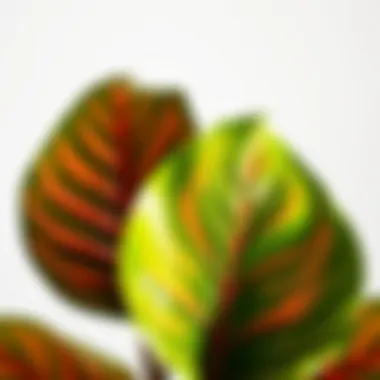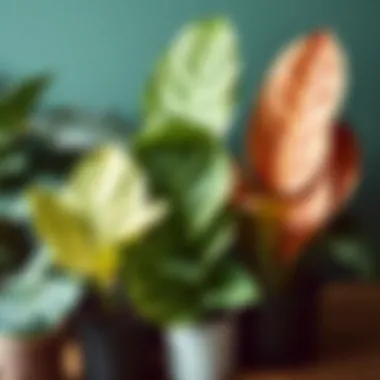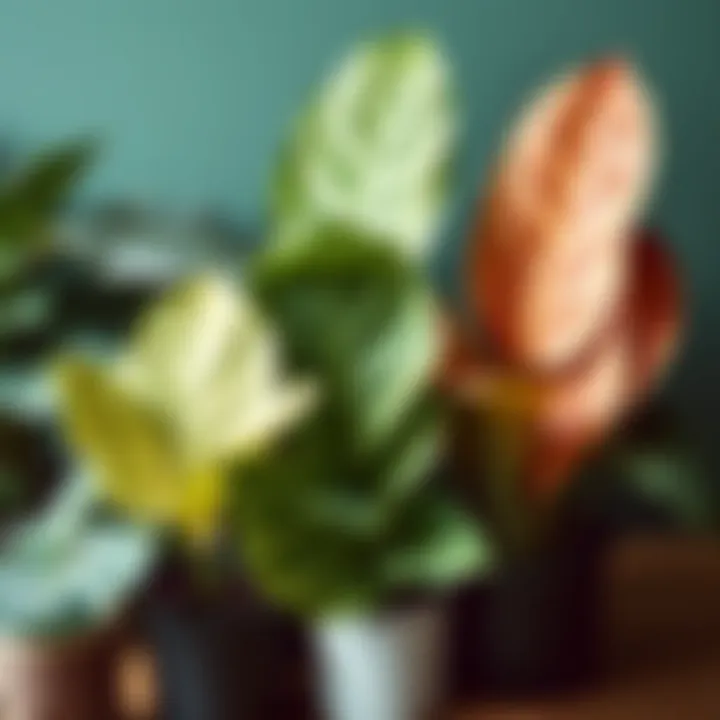Understanding the Cost of Elephant Ear Plants


Intro
Elephant ear plants, known scientifically as Alocasia, Colocasia, and Xanthosoma, are famed not only for their stunning foliage but also for their ability to transform spaces, both indoors and outdoors. Their large, dramatic leaves create an enticing visual impact, making them a popular choice among plant enthusiasts and designers alike. However, beyond their aesthetic appeal, understanding the cost associated with these plants is essential for anyone considering adding them to their collection.
The price of elephant ear plants can fluctuate significantly due to various factors. From the species and size to sourcing methods and regional pricing trends, each element has a story to tell. For example, a small Colocasia esculenta might be more budget-friendly than a mature Alocasia zebrina with its distinctive zebra-like stems.
In the following sections, we will delve deep into the factors that influence the cost of these beautiful plants, explore current market trends, and provide insights that will aid homeowners, designers, retailers, and DIYers in making informed purchasing decisions.
Embracing the knowledge of what drives plant pricing is crucial; it ensures that whether you're sprucing up your living room or creating a garden that turns heads, you know what to expect in terms of cost.
Let’s jump into the fascinating dynamics of elephant ear pricing!
Prologue to Elephant Ear Plants
The elephant ear plant, with its large, dramatic foliage, is more than just a pretty addition to gardens and homes. It offers a myriad of benefits and considerations for both novice and experienced plant lovers. From purifying the air to enhancing aesthetic appeal, understanding the role these plants play is crucial.
For homeowners, elephant ear plants can add a tropical touch, bringing life and vibrancy into indoor spaces or outdoor gardens. Designers appreciate them for their ability to create focal points that draw the eye, while retailers find potential for profit with their high demand. Even DIY enthusiasts might enjoy the challenge of cultivating these plants, making them a valuable topic for a broad audience.
When diving into the various aspects of elephant ear plants, it’s clear that price isn’t the only factor to consider. There are also environmental needs, aesthetic gains, and care requirements that elevate the conversation around their cost. Therefore, the importance of understanding elephant ear plants extends beyond their monetary value; it's about grasping their overall significance in our homes and landscapes.
Defining Elephant Ear Plants
Elephant ear plants, categorized primarily under the Colocasia and Alocasia genera, are known for their giant, heart-shaped leaves that can reach impressive sizes, often comparable to an actual elephant's ear. These perennial plants thrive in moist environments, making them a favorite in tropical and subtropical regions. They are often found in a variety of colors, ranging from deep greens to more pronounced hues, adding visual interest to any setting.
Apart from their genetic classification, elephant ears are notable for how they can transform spaces. Individuals may choose these plants for their ability to create lush, serene environments, suitable for both bustling urban areas and quiet country homes. They serve both ornamental and functional roles in the garden, attracting various wildlife and providing shade to smaller plants.
Cultural Significance
The cultural roots of elephant ear plants run deep. In many tropical cultures, these plants are not only decorative but also serve practical purposes. For instance, the leaves of the Colocasia species are used in culinary dishes, while the water-drenched roots serve as sustenance in some regions. Thus, elephant ear plants thread a narrative of utility and beauty.
Moreover, in landscaping designs, especially in regions prone to humidity, these plants symbolize abundance and vitality. Communities often use them to represent resilience; the large leaves can withstand strong winds and heavy rainfall, embodying strength in nature. From cultural festivals that highlight their significance to rituals that incorporate them, elephant ear plants continue to thrive both in the wild and within human habitats.
"The true essence of a plant isn't just how it looks, but how it intertwines with the fabric of life around it."
Understanding the cultural implications behind elephant ear plants enriches our appreciation for them. It connects us with traditions, purposes, and histories that transcend gardens.
In summary, elephant ear plants possess a multidimensional essence that reflects their importance beyond mere decoration. Recognizing their definitions and cultural relevance sets a solid foundation for exploring their costs, care requirements, and overall value.
Types of Elephant Ear Plants
Understanding the diverse types of elephant ear plants is essential for anyone contemplating the addition of these stunning foliage plants to their space. The category of elephant ear plants encompasses different species that offer unique appearances, growing habits, and care requirements. Each type brings its distinct flavor, contributing not only to garden aesthetics but also to the overall ambiance of indoor spaces.
Colocasia
Colocasia, often referred to as the taro plant, is synonymous with the classic elephant ear look due to its large, heart-shaped leaves. Known for its impressive size, this type can grow up to six feet tall under optimal conditions. The leaves exhibit a rich green hue, while some varieties flaunt shades of purple or even variegation, making them a showstopper in any garden.
Colocasia thrives in moist, tropical environments, so ensuring they receive proper water and humidity is critical. Originating from regions like Southeast Asia and India, these plants are quite adaptable but prefer well-draining soil. For homeowners who value the cultural culinary aspects, Colocasia also is edible, rich in nutrients, and often used in dishes in various cuisines. However, be mindful of potential toxins in raw forms; proper cooking is necessary.
Alocasia
Alocasia, another member of the family, boasts a more sculptural appearance. With its strikingly upright leaves that can reach impressive dimensions, Alocasia has seen a spike in popularity among designers and plant enthusiasts alike. Varieties like Alocasia amazonica, with its glossy, arrow-shaped leaves veined with silver, add a dramatic touch to interiors.
Unlike its Colocasia counterpart, Alocasia tends to prefer drier soils and more moderate watering. This preference means it can tolerate indoor environments better than excessive moisture outside. Yet, achieving the right watering balance requires some practice; too little can lead to wilting, while too much can cause root rot. Its beautiful foliage can significantly enhance the aesthetic value of your home or garden, making it a smart choice for those looking for a touch of tropical flair.
Xanthosoma
Lastly, Xanthosoma presents a slightly different appeal, often less recognized yet remarkable in its right. Known as the elephant ear plant but not to be confused with the previous types, Xanthosoma offers a variety of vibrant leaves, ranging from dark greens to striking variegated patterns. One notable feature is its ability to adapt to various soil types, making it a low-maintenance option for novice gardeners.
This plant, native to tropical America, also has some edible varieties known for their starchy tubers. While fewer people grow Xanthosoma for culinary use, its hardiness in garden designs cannot be overlooked. It can grow well in partial shade, making it a versatile choice for spaces that may not receive full sunlight.
In summary, exploring the various types of elephant ear plants reveals not just the beauty they bring but also the diverse care and environmental considerations they entail. Each variety has unique traits that can appeal to different gardening situations, whether in an indoor setting or as part of a lush outdoor landscape. Understanding these differences is crucial when making informed decisions that align with one's aesthetic goals and horticultural skills.


"A plant is not just a decoration; it’s a living piece of art that enhances our surroundings."
For further insight into these intriguing plants, you can check out resources such as Wikipedia and Britannica.
Factors Affecting Cost
One crucial consideration is plant size. The height and width of an elephant ear plant can dictate its price substantially. Larger plants, boasting fuller leaves, often come at a premium compared to smaller, younger specimens. Homeowners eager to make a statement with mature plants may be willing to spend more upfront to skip the slower growth phase. Thus, knowing where you stand with respect to size preferences can save you from sticker shock at the nursery or while online shopping.
Another significant aspect is species variability. As mentioned before, elephant ear encompasses a few different species including Colocasia, Alocasia, and Xanthosoma. Each variety carries its own price range. For example, the Alocasia varieties can sometimes fetch a higher price due to their exotic look and particular care requirements. Collectors especially seek rarer species, pushing up demand and, subsequently, prices. When diving into the world of elephant ear plants, being aware of the species you're interested in can provide clarity on what to expect financially.
Finally, the health of the plant is paramount. A vibrant, thriving elephant ear plant can set you back a bit more but offers peace of mind regarding its ability to adapt and flourish in your environment. Conversely, a plant showing signs of neglect or disease might lure you in with a cheaper price but can lead to unforeseen costs in rehabilitation. The adage "you get what you pay for" rings true here. Keeping an eye and a budget for the health status of the plants you're eyeing ensures that you're making a worthwhile investment.
Before making a purchase, always inspect the plant thoroughly. Look for lush foliage, consistent leaf color, and a strong root system to ensure you're bringing home a healthy specimen.
By comprehending these factors—size, species, and health—consumers can navigate the market with a keen sense of value, ultimately leading to a better selection of elephant ear plants tailored to their needs. Understanding how these elements intertwine provides a solid foundation in your journey through the captivating world of elephant ear plants.
Retail Avenues for Purchase
When considering the cost of elephant ear plants, understanding where to purchase them is equally important. Different avenues not only affect pricing but also the overall quality, health, and variety available to buyers. Each retail outlet brings its own set of advantages and drawbacks, making it vital for potential buyers to weigh their options carefully to find the one that suits their needs best.
Local Nurseries
Local nurseries often provide an intimate shopping experience for plant enthusiasts. One significant advantage of buying from a nursery is the opportunity to see plants in person. Here, you can observe the condition of the elephant ear plants before purchasing, ensuring you select a healthy specimen. Nurseries frequently carry a selection of species that are locally popular, catering to regional preferences and climate.
Additionally, purchasing from local establishments often allows for direct interaction with knowledgeable staff. Experts can provide personalized advice on caring for elephant ear plants, considering the soil and climate specific to the buyer’s location.
However, prices at local nurseries can sometimes be higher than those found online. This is partly due to the overhead costs of maintaining a physical space. Moreover, limited stock availability might restrict the variety one can choose from, especially if the nursery is small.
Online Retailers
Online retailers have gained tremendous popularity in recent years due to their convenient shopping experience and vast selection. Platforms like Amazon and specialized plant websites streamline the process, allowing buyers to browse a wide range of elephant ear plants from the comfort of their own home.
The main advantage of online shopping is the ease of comparison. Buyers can quickly check prices, species availability, and user reviews, making informed decisions without stepping foot outside. Additionally, online retailers often offer competitive prices, as they can source plants from various growers and pass on savings to customers.
However, purchasing online comes with its challenges. Photos often do not do justice to the actual plant's condition. Buyers may receive a plant that looks entirely different from what was depicted in the listing. Additionally, shipping costs can add up, and there’s the risk of plants getting damaged during transit.
Plant Expos and Markets
Plant expos and local markets provide yet another avenue for acquiring unique elephant ear plants. These events are often vibrant gatherings of enthusiasts, offering a chance to see a diverse range of species, sometimes even rare varieties that you might not find anywhere else.
At these venues, you can directly interact with vendors who are usually passionate about their plants, providing insights and care tips. It's a wonderful opportunity to buy healthily grown plants, often from local cultivators who specialize in particular species.
On the downside, expos can be overwhelming due to the sheer volume of options. Prices can vary wildly depending on the vendor and species, and the lack of variety in certain markets may lead to missed opportunities for better deals found elsewhere.
In the quest for the perfect elephant ear plant, knowing where to look and what to look for can significantly affect your satisfaction with both the plant and the price you pay.
By carefully considering these retail avenues, buyers can make informed choices that balance cost, quality, and accessibility, leading to a rewarding experience in adding elephant ear plants to their homes or gardens.
Regional Pricing Discrepancies
Understanding the geographic variations in pricing for elephant ear plants is crucial for anyone looking to expand their collection or make a significant purchase. The prices can be influenced by a variety of factors, reflecting the local demand, availability, shipping costs, and even the overall economic climate of the region. Knowing these disparities can help buyers better anticipate their spending and make informed decisions based on local market trends.
Urban vs. Rural Pricing
When it comes to the availability and cost of elephant ear plants, there’s often a stark contrast between urban and rural settings. Cities, teeming with life and plant enthusiasts, usually have a wider variety of both species and sizes. This proliferation often leads to competitive pricing. For instance, local nurseries in metropolitan areas might stock popular varieties like Colocasia esculenta or Alocasia amazonica at lower prices due to higher sales volume.
Conversely, in rural areas, where specialty nurseries are limited, the cost can skyrocket. Purchasers might find themselves paying a premium simply for the convenience of obtaining these plants. Availability can often dictate pricing—if a much-desired species is scarce in an area, its price may sharply increase. For example, if you happen to live in a small town where few vendors specialize in these plants, it's not uncommon to see prices nearly double what they might be in a larger urban nursery.
"In regions where elephant ears are a rarity, locals may pay more, not just for the plant but for the experience of having something unique in their garden."
Climate Influences on Cost
The climate of a region plays a significant role in the cost of elephant ear plants. These plants thrive in warm, humid environments, which can influence local nurseries and retailers. In areas with more temperate climates, such as parts of Florida or Southern California, there tends to be a healthy supply, leading to more reasonable prices.


However, if you reside in a region where the climate is less conducive to growing, like colder northern states, plants may be harder to acquire and therefore more expensive. Nurseries catering to these areas often import plants from warmer climates, adding shipping costs to the retail price.
Moreover, places with a shorter growing season also experience fluctuations. Keep in mind that demand spikes as the planting season begins, often causing prices to rise dramatically in spring. Homeowners or designers should plan accordingly to avoid exorbitant costs during peak seasons.
In summary, the importance of understanding regional pricing discrepancies cannot be understated. Knowing how urban vs. rural pricing and climate can affect costs equips buyers with the insights needed to budget effectively for their botanical endeavors.
Comparative Analysis of Prices
When it comes to elephant ear plants, understanding the pricing landscape is like navigating a dense jungle—overwhelming yet fascinating. This section unpacks the complexities of pricing, helping both seasoned plant owners and newbies alike gain a solid understanding of what drives costs. Delving into the comparative analysis of prices enables potential buyers to make educated choices, ensuring they strike the right balance between quality and budget.
Analyzing prices offers insight into various elements such as the type of species in question, their sizes, and how their worth can change with market trends. With the global interest in plant aesthetics on the rise, knowing what to expect price-wise can enhance your shopping experience and help you avoid overspending.
Price Range by Size
When it comes to elephant ear plants, size genuinely matters. Larger specimens not only turn heads but also come with a heftier price tag. Typically, you can find smaller plants, around one to two feet, priced anywhere from $10 to $30. These smaller ones are great for windowsills or smaller spaces, just peeking their big leaves over the edge.
On the flip side, if you fancy something more substantial for your garden, a three to four-foot plant might set you back $50 to $150, depending on its health and species.
Moreover, as you venture into larger sizes—those majestic giants that can soar to six feet or more—you might encounter prices exceeding $200. These plants are like the rock stars of the garden; they draw attention and can elevate any outdoor space with their dramatic flair.
Key Price Points by Size:
- Small (1-2 ft): $10 - $30
- Medium (3-4 ft): $50 - $150
- Large (5 ft+): $200 and up
Price Difference by Species
The world of elephant ear plants is diverse, where each species brings its own flair along with a unique price tag. Not all elephant ears are created equal, and you’ll feel the difference in your wallet.
For instance, the Colocasia species tends to be more affordable, making it a go-to for many plant lovers. You might snag a healthy Colocasia esculenta for around $20 to $40. However, if you’re eyeing more exotic options like Alocasia amazonica, prepare to fork out $40 to $100 or even more, if it's a rare variety. The Xanthosoma species also falls into a mid-range category, with prices generally in the $30 to $70 range.
To summarize the pricing variations:
- Colocasia: $20 - $40
- Alocasia: $40 - $100+
- Xanthosoma: $30 - $70
Understanding these price differences by species helps enthusiasts choose wisely based on their budget while still allowing them to explore the particular styles they appreciate. With this knowledge, you’ll be well-prepared to shop around, compare options, and ultimately make purchases that suit both your aesthetic vision and budget constraints.
"Knowledge is power, and when it comes to buying elephant ear plants, it pays to be informed about the prices that's on the market."
In the ever-evolving plant market, these comparative analysis points can enlighten consumers, guiding them through the plethora of choices and helping them to cultivate an environment that resonates with their taste and financial plan.
Ongoing Care and Maintenance Costs
Caring for elephant ear plants involves more than just understanding their initial purchase price; it requires a consideration of ongoing maintenance costs that can extend the life and beauty of these exuberant specimens. These plants, known for their dramatic tropical leaves, thrive under specific conditions and require appropriate care to maintain their health and vibrancy. Being aware of these costs is important for any homeowner, designer, retailer, or DIYer who wants to invest not only money but also time and effort into their green space.
Watering and Fertilization
Watering is a fundamental part of maintaining elephant ear plants. They tend to prefer moist soil, making it crucial to keep an eye on the moisture levels. Generally, they might need watering every one to two days, depending on the climate and the plant's environment. During hotter months, you may find yourself reaching for the watering can more frequently. If the leaves start drooping, it's often a sign that the plant is thirsty.
As for fertilization, applying a balanced fertilizer every couple of months during the growing season can promote robust growth. Liquid fertilizer mixed into the watering regime helps provide necessary nutrients. However, doing too much can lead to fertilizer burn, damaging the plant. The cost of fertilizers can vary, but a good quality option is necessary, and setting aside about $10 to $20 for these monthly necessities is reasonable.
Pest Management
Keep an eye out for pests, as they can undermine the health of your elephant ear plant. Common culprits include aphids, spider mites, and mealybugs. Manual removal might suffice for minor infestations, but most often, you'll need to resort to insecticidal soaps or organic pesticides. Regularly inspecting the undersides of leaves and maintaining good airflow can mitigate infestations. The costs of treatments can vary, with a decent pesticide often costing around $15.
"Prevention is always better than cure," especially when it comes to pests.
Repotting and Soils
As your elephant ear plant grows, it will inevitably need repotting—an investment that can contribute to its overall health and longevity. Generally, these plants ask to be repotted every couple of years. A larger pot allows room for root expansion, which is vital for nutrient uptake and water absorption. Quality potting soil is equally important; it should be rich in organic matter to retain moisture without becoming soggy. A good potting mix can cost anywhere from $10 to $25. During repotting, consider the cost of new pots as well, which can range depending on size and material.
In summary, ongoing care and maintenance for elephant ear plants demands attention and funds. From regular watering and fertilization to pest management and repotting, understanding these costs helps set realistic expectations for maintaining a thriving specimen.
Market Trends for Elephant Ear Plants


Understanding the market trends surrounding elephant ear plants is crucial for homeowners, designers, and enthusiasts alike. The popularity of these botanical wonders has catapulted them into the spotlight of interior and exterior design. Knowing the trends can guide buyers on where to find the best prices and what to expect in terms of quality and availability.
Internet Influence on Pricing
The internet has become a melting pot for plant shopping, including elephant ear plants. Online marketplaces like Etsy, Amazon, and specialized plant retailers now offer a vast selection. Prices fluctuate according to various factors such as availability, shipping costs, and regional demand. Notably, plants sold online often come with a purview of potential extra charges, such as shipping and handling fees.
Moreover, social media plays a significant role in determining pricing. Platforms like Instagram and Pinterest fuel interests, where gorgeous photos of flourishing elephant ear plants influence consumer tastes. When a particular cultivar starts trending, prices can skyrocket overnight. This creates both opportunities and challenges for the savvy shopper.
Additionally, buyer reviews and ratings can easily tip the scales of trustworthiness toward certain vendors, guiding customers to make worthwhile purchases. In this context, it’s essential to compare multiple online retailers to find the best quality-price balance.
"With the rise of online shopping, prices for elephant ear plants are not just about the plant itself but about navigating a digital marketplace."
Rising Popularity and Effects
The growing affection for elephant ear plants is undeniable. Interior designers have increasingly recognized their dramatic foliage as a perfect touch for creating tropical vibes in homes and commercial spaces. This demand has a ripple effect on prices. As more enthusiasts seek these plants for their aesthetic value, sellers from nurseries to retailers ramp up supply, often at premium rates.
Some factors contributing to their popularity include:
- Visual Appeal: The broad, sculptural leaves command attention and can transform any space.
- Versatility: These plants thrive in both gardens and indoor settings, making them a versatile choice.
- Unique Varieties: The emergence of new cultivars with unique leaf patterns and colors enriches the market.
Yet, this rising trend has also stimulated conversations about sustainable practices in the plant industry. Consumers are becoming increasingly conscientious, often favoring ethically sourced plants.
Retailers that adopt eco-friendly practices may see not only increased sales but also customer loyalty, as buyers can feel good about their purchases.
Therefore, the interplay of popularity and sustainability is set to shape future pricing trends for elephant ear plants.
Value Proposition of Elephant Ear Plants
Aesthetic and Functional Benefits
Elephant ear plants are a true feast for the eyes, boasting lush, oversized leaves that can transform any space into a tropical paradise. These plants have become quite the centerpiece in gardens and homes alike. Their unique shapes and vibrant green or even variegated colors offer striking visual impact that few other plants can provide.
From a functional standpoint, elephant ears also play a role in improving air quality. Like many foliage plants, they can help filter pollutants in the air, making your indoor environment healthier. For designers and homeowners alike, this dual functionality - beauty and utility - is a major plus.
Additionally, these plants thrive in various light conditions, making them a versatile choice for both indoor and outdoor settings. They can be placed in shady spots of your garden or positioned in sunlit corners indoors, allowing for immense flexibility in design. This adaptability is appealing for those who want to create a serene atmosphere, further solidifying their value in both aesthetic and functional realms.
Long-term Investment in Indoor Nature
Investing in elephant ear plants is much like putting money into a high-quality piece of art; it pays off over time. The vibrant foliage and breathtaking size of these plants means they will not only captivate your guests but also stand the test of time if cared for properly. They require attention, yes, but the effort is often rewarded in the form of extended life and growth.
By adding these beautiful plants to your collection, you are essentially investing in your mental well-being. Studies show that indoor plants, particularly large ones like elephant ears, can boost mood and increase productivity. In an age where stress is a common companion, making such a choice is priceless.
When compared to other houseplants, elephant ears can seem pricier, but their longevity and aesthetic appeal make them an investment. With suitable care practices, these plants can grow significantly and maintain their vigor for many years, making the initial cost worthwhile. Plus, the potential for propagation offers even more value, as you can create new plants from your original, providing even greater return on your investment.
"The unique beauty of an elephant ear plant can be likened to having a slice of the tropics right in your living room or garden."
As you embark on your journey of nurturing elephant ear plants, consider the tremendous value they bring—not just as flora, but as vital elements that enhance both space and well-being.
Finale
In summarizing the essence of understanding the costs associated with elephant ear plants, readers can grasp the depth of considerations that come into play when investing in these vibrant greenery options. The allure of elephant ear plants lies not just in their striking aesthetics but also in the broad spectrum of factors influencing their pricing. Homeowners, designers, and enthusiasts alike benefit significantly from a clear grasp of what influences these costs. From plant size and species variability to regional market discrepancies, every element intertwines to shape overall expense.
By dissecting these aspects, one can make more informed decisions when purchasing. Knowing where to buy—be it local nurseries, online retailers, or plant expos—adds another layer of strategic planning. Having this foundational knowledge empowers buyers, ensuring they appreciate both the value and the investment of caring for such captivating plants.
Moreover, understanding ongoing care and maintenance costs helps to align expectations with reality. Elephant ear plants, while beautiful, necessitate a dedicated approach to upkeep that can impact overall long-term investment.
"Investing in nature shouldn’t be a gamble but rather a thoughtful engagement with beauty and practicality."
In essence, recognizing that costs are only one part of the equation enables a richer appreciation for the trade-off between investment and the aesthetic value they deliver.
Summary of Key Points
- Categories of Influence: The cost of elephant ear plants is impacted by species type, size, health, and regional pricing dynamics.
- Purchase Avenues: Local nurseries, online options, and plant markets provide different pricing structures and availability.
- Maintenance Expenses: Regular care, pest management, and repotting are instrumental in ensuring the longevity of your elephant ear plants and should be factored into the overall cost.
- Market Trends: A burgeoning popularity in these plants ties back to social media influences and gardening trends, affecting pricing and availability.
Final Thoughts on Costs and Value
The beauty of elephant ear plants transcends merely their purchase price. As trends evolve and the demand for greenery increases, the cost factors will inevitably fluctuate. This offers both challenges and opportunities for buyers.
Investing thoughtfully means recognizing that a higher initial cost may lead to lush foliage and a stunning visual centerpiece in the long run. Homeowners and designers alike can find joy in the transformation these plants bring to any space.
Ultimately, engaging in rewarding dialogue among the gardening community can yield insights and tips on where to find the best options—both in terms of cost and plant quality. Whether one is starting a new gardening adventure or enhancing an existing collection, understanding the financial implications enhances the joy of growing these beautiful plants.















